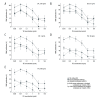Pharmacodynamic Drug-Drug Interaction on Human Peripheral Blood Mononuclear Cells Between Everolimus and Tacrolimus at the Therapeutic Concentration Range in Renal Transplantation
- PMID: 33633104
- PMCID: PMC7924008
- DOI: 10.12659/AOT.928817
Pharmacodynamic Drug-Drug Interaction on Human Peripheral Blood Mononuclear Cells Between Everolimus and Tacrolimus at the Therapeutic Concentration Range in Renal Transplantation
Abstract
BACKGROUND Everolimus (EVL) plus tacrolimus (TAC) therapy is effective and safe in renal transplantation. However, the pharmacokinetic and pharmacodynamic information for EVL combined with TAC is limited. We investigated the pharmacodynamic drug-drug interaction between EVL and TAC at their therapeutic concentration range. MATERIAL AND METHODS Isolated peripheral blood mononuclear cells (PBMCs) from 22 healthy participants aged 22 to 24 years were cultured with concanavalin A (Con A) in the presence of EVL and/or TAC for 4 days, and the proliferation rate of the PBMCs was calculated. RESULTS TAC promoted the inhibitory efficacy of EVL against the mitogen-activated proliferation of PBMCs at the EVL therapeutic concentration range. When 0.175 ng/mL or more of TAC was combined with 30 ng/mL or more of EVL, the antagonistic effect of TAC on the inhibitory efficacy of EVL against the mitogen-activated proliferation of PBMCs was observed. Conversely, when 0.4 ng/mL TAC and 10 ng/mL or more of EVL were combined, the antagonistic effect of EVL on the inhibitory efficacy of TAC against the mitogen-activated proliferation of PBMCs was observed. CONCLUSIONS The pharmacodynamic synergistic efficacy of EVL and TAC in combination on mitogen-activated PBMCs was evident at the therapeutic concentration range, which is used in renal transplantation. However, these drugs antagonize each other to suppress the proliferation of activated PBMCs at concentrations higher than those clinically used.
Conflict of interest statement
None.
Figures




Similar articles
-
Optimal everolimus concentration is associated with risk reduction for acute rejection in de novo renal transplant recipients.Transplantation. 2010 Jul 15;90(1):31-7. doi: 10.1097/TP.0b013e3181de1d67. Transplantation. 2010. PMID: 20517177 Clinical Trial.
-
Interaction between everolimus and tacrolimus in renal transplant recipients: a pharmacokinetic controlled trial.Transplantation. 2010 Apr 27;89(8):994-1000. doi: 10.1097/TP.0b013e3181ccd7f2. Transplantation. 2010. PMID: 20335831 Clinical Trial.
-
Prospective clinical trial comparing two immunosuppressive regimens, tacrolimus and mycophenolate mofetil versus everolimus and low-dose cyclosporine, in de novo renal transplant recipients: results at 6 months follow-up.Transplant Proc. 2009 May;41(4):1152-5. doi: 10.1016/j.transproceed.2009.03.019. Transplant Proc. 2009. PMID: 19460503 Clinical Trial.
-
Focus on mTOR inhibitors and tacrolimus in renal transplantation: pharmacokinetics, exposure-response relationships, and clinical outcomes.Transpl Immunol. 2014 Jun;31(1):22-32. doi: 10.1016/j.trim.2014.05.002. Epub 2014 May 24. Transpl Immunol. 2014. PMID: 24861504 Review.
-
Pharmacokinetic considerations related to therapeutic drug monitoring of tacrolimus in kidney transplant patients.Expert Opin Drug Metab Toxicol. 2017 Dec;13(12):1225-1236. doi: 10.1080/17425255.2017.1395413. Epub 2017 Oct 30. Expert Opin Drug Metab Toxicol. 2017. PMID: 29084469 Review.
References
-
- Naesens M, Kuypers DR, Sarwal M. Calcineurin inhibitor nephrotoxicity. Clin J Am Soc Nephrol. 2009;4(2):481–508. - PubMed
-
- Berger SP, Sommerer C, Witzke O, et al. Two-year outcomes in de novo renal transplant recipients receiving everolimus-facilitated calcineurin inhibitor reduction regimen from the TRANSFORM study. Am J Transplant. 2019;19(11):3018–34. - PubMed
-
- Motzer RJ, Escudier B, Oudard S, et al. Efficacy of everolimus in advanced renal cell carcinoma: A double-blind, randomized, placebo-controlled phase III trial. Lancet. 2008;372(9637):449–56. - PubMed
MeSH terms
Substances
LinkOut - more resources
Full Text Sources
Other Literature Sources
Medical

